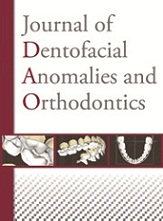No CrossRef data available.
Article contents
Multidisciplinary treatment plan for multiple dental ageneses associated with hypohidrotic ectodermal dysplasias
Published online by Cambridge University Press: 25 September 2014
Abstract
Hypohidrotic ectodermal dysplasias (HED) are a heterogeneous and complex group of syndromes characterized by a dental craniofacial phenotype associated with severe oligodontia, maxillary hypoplasia with broad face and most notably facial concavity. Cephalometric analyses show insufficient maxillary sagittal growth, a protruded mandible, reduced facial and ramus heights, as well as basicranial changes. Early diagnosis and care from a multidisciplinary team are essential. In the primary dentition, initial prosthetic treatment is recommended and may possibly be combined with interceptive orthodontic treatment. In the mixed dentition, treatment of a transverse maxillary deficiency consists in installing a removable expander or a quadhelix in the case of moderate phenotypes where there is adequate anchorage support. To achieve mandibular anterior repositioning of the maxilla the patient must wear a facial mask. In the permanent dentition, the important steps are correlated with the pre-implant and pre-prosthetic orthodontic adjustments, as well as the presurgical orthodontic preparation that precedes subsequent single or double jaw orthognathic surgery. Temporary skeletal anchorage with mini-screws or plates can be used in cases of insufficient anchorage.
- Type
- Research Article
- Information
- Copyright
- © RODF / EDP Sciences


